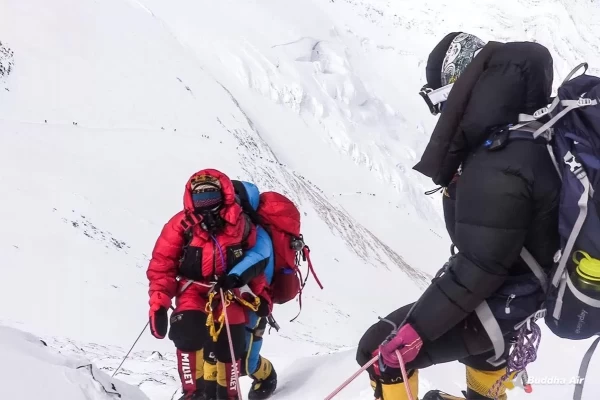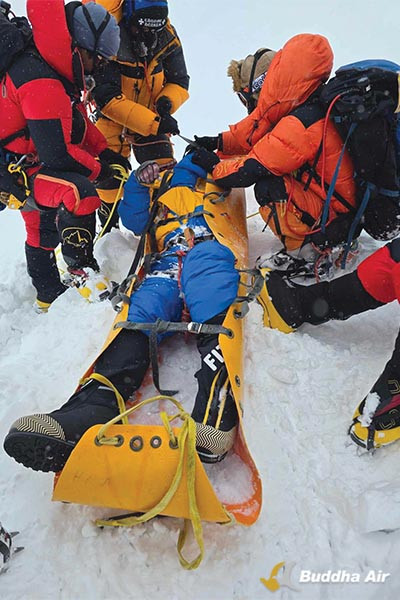How Rescuers Retrieve Dead Bodies From Everest

At 11:57 a.m., two Mongolian climbers—Usukhjargal Tsedendamba, 53, and Purevsuren Lkhagvajav, 31— successfully stood atop Everest. They hugged each other to celebrate. It was a lifetime achievement, so they took photos. Standing at the highest point on earth, they briefly looked around before descending to the mountain’s base camp.
It was on May 13, 2024. Before heading to the summit, these foreign climbers were briefed that the weather would remain good on their summit day. But the day turned out to be windy. They swiftly began to descend. They were already exhausted. Running out of energy and oxygen on their way back, both of the climbers collapsed at the South Col (8,600 meters). 
None were there to rescue them. The climbers were on a mission to climb Everest in alpine style, which means climbing without supplemental oxygen and Sherpa support. They, however, had obtained climbing permits from 8K Expeditions. The expedition was responsible only for base camp service. Nothing more than that. 8K Expeditions was the agency used to provide base camp services. So, the tourism authorities pressured it to bring them back to base camp at any cost. The government authorities feared that the dead body could be left there on the mountain slope. So, they asked the expedition agency to bring dead bodies back to Kathmandu and hand over the bodies to their respective families.
Pressure was mounting on the expedition agency as the dead bodies were blocking the traffic. So, the expedition agency did some homework, such as getting consent from family members on whether they were capable enough to ensure the expenses required for rescue, arranged helicopters and deployed them after taking weather updates. Climbers must get insured for rescue in case of death or injury before heading to the mountain. Since the Mongolian climbers were on a mission to climb Everest, there was confusion about which insurance company would bear rescue expenses. That’s why the company involved in the dead body rescue had to agree to bear the expenses to be incurred for the rescue mission.
The search and rescue team deployed from the agency spotted dead bodies at the South Col. Two Mongolian climbers were hanging on a rope fixed to help climbers reach the Everest summit.
Everest traffic was obstructed. To ease traffic, rescuers removed the dead bodies from the safety line. “Since traffic was disturbed, we first managed to take the body to a safer place. The body was brought back to the base camp a few days later,” said Lakpa Sherpa, one of the managers of the 8K Expedition. That’s why we removed the dead body from the summit trail for a few days.”
Bringing the body back to base camp remains always a herculean task. Days after removing dead bodies from the safety line, the expedition agency arranged a six-member rescue team. It took a total of five days to bring the dead body back to the base camp.
“We six Sherpas risked our life to bring the dead body to base camp from South Col,” said Pechhumbee Sherpa, lead rescuer, “We couldn’t bring the dead body of another Mongolian climber. That’s still there.”
The dead body of another Mongolian climber, Purevsuren, is still lying there on the slope of the mountain. Pechhumbee believes it’s risky to attempt to bring the dead body. Further, his family isn’t interested in investing in bringing the dead body back to the base camp. He wasn’t insured for rescue in case of his death on Everest either.
“We can see it but cannot go where it’s placed. The rescue of a dead body may claim the lives of rescuers. So, it’s left there, and we don’t know whether we will successfully bring it down,” said Pechhumbee.
Bringing dead bodies to base camp from the death zone demands several essentials: skilled high-altitude rescuers, tens of thousands of dollars, climbing gears, helicopter, logistics, and good coordination among stakeholders. The expedition agency estimated at least $9,000,000 was spent for bringing the dead body of a Mongolian climber. The deceased family covered the entire expense.
According to the expedition agency, managing the rescue expenses always remains a major challenge when the climber dies in the mountain. The number of high-altitude Sherpas increases if the climber collapses in the high altitude. The risk also multiplies if the dead body is in high-altitude areas. So is the case with expenses as well.
Rescuers need to use helicopters to organize long-line rescues if the dead bodies are left on the slopes of mountains. Long-line rescue may turn deadly for rescuers as well.
Last year, Phurba Sherpa died on Everest while rescuing Dipendra Singh Khatri, a capitation of the Nepal Army, while being deployed to the Everest high camp as part of the Everest cleanup campaign.
Although expedition agencies should mandatorily bring dead bodies from mountains and handover them over to the respective families, if any climber dies there in the mountain, most bodies remain frozen there in the mountain for decades.
You may also like: Get To The Highest Peaks Of The World Without Trekking
This year, five climbers died on Everest. But only a dead body was brought down to base camp. The state of the three missing climbers is unknown.
Expedition records show more than 340 climbers have died on Everest since the expedition began in 1921. One-third of them are said to be left on the slopes of the world’s highest peak.
Nepal has a policy to bring all the dead bodies from the mountain. But some dead bodies are left there for a couple of reasons: family’s wish to stay in the mountains in case of death, insufficient budget, and unavailability of rescuers. Many rescuers don’t want to risk their lives to rescue dead bodies from the mountains under various pretexts.
But the Department of Tourism, the tourism body under the Ministry of Culture, Tourism, and Civil Aviation, has been tightening the screws on expedition agencies to bring the dead bodies back to base camp and then handover them over to the respective families. The Department has started to stop the climbing certificate for entire team members in case the dead body of any member is left in the mountain.
“Dead bodies shouldn’t be left on the mountains. That’s a punishable crime,” said Rakesh Gurung, director at the DoT. “But bodies are piling up there in the mountain for some reason. We don’t want to see this situation.”
